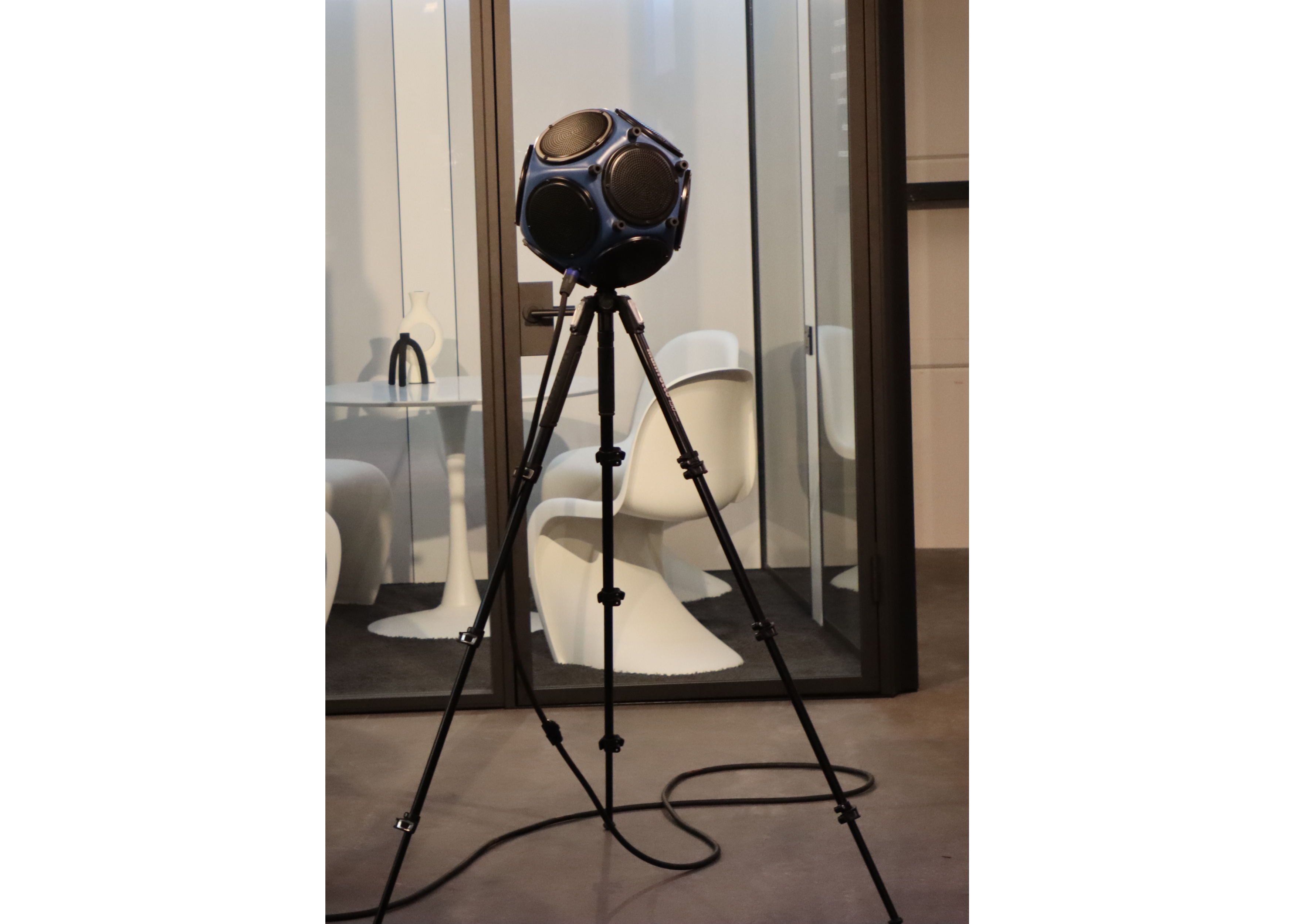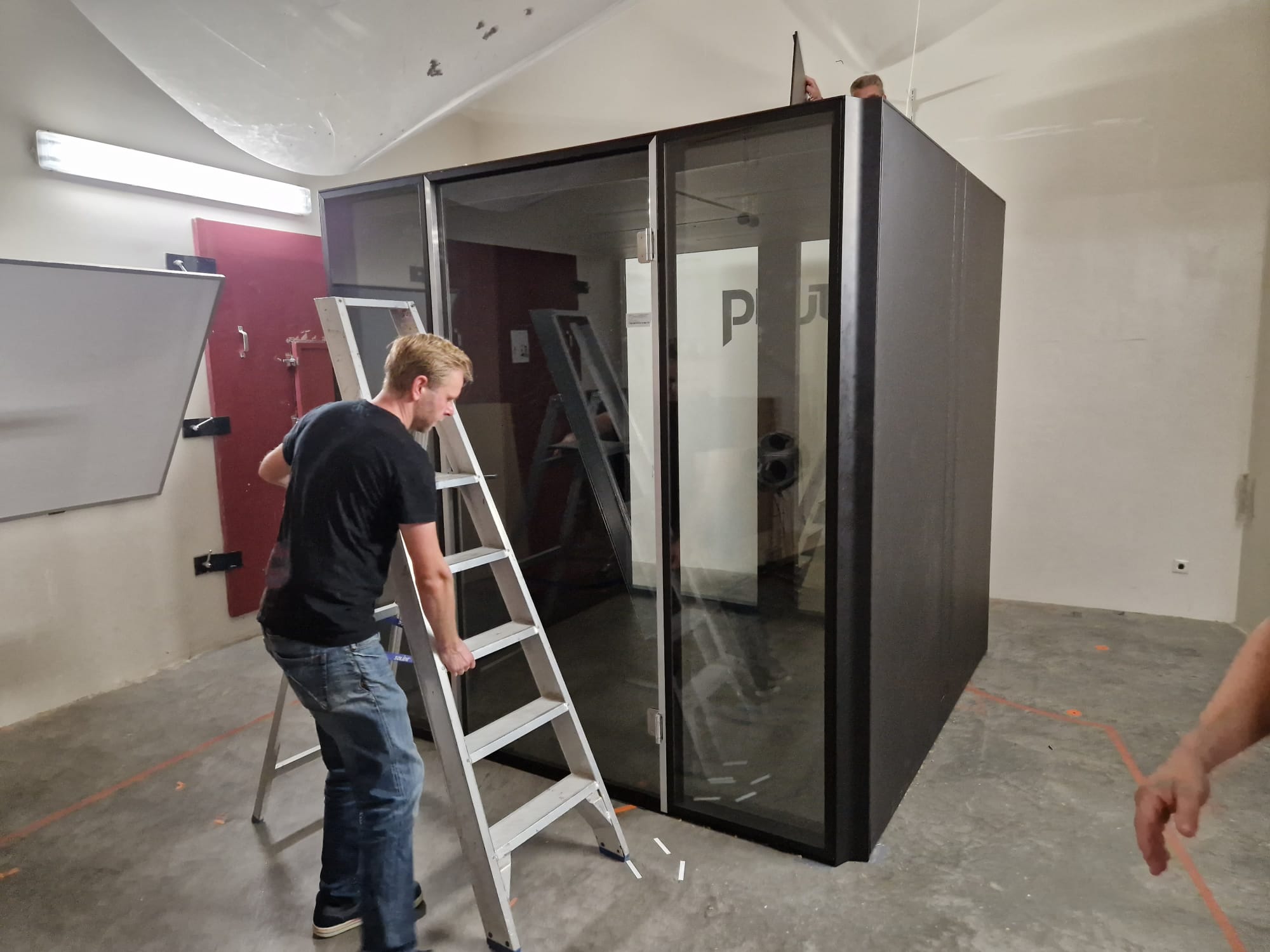Testing the acoustics of our solutions is an important aspect of what we do and we often share the results with our customers. People regularly ask us which tests we perform and how we do them. Before officially testing our solutions, we start by subjecting them to extensive testing in our own professional lab environment. All official testing takes place at Peutz. We think it would help if we explained what we do and why we do this.
Testing acoustics with an office pod
Because the traditional measurement of airborne sound insulation (Rw in a lab setting under standardised conditions, R’w is the field measurement value) is not suitable for pods. Rw measures airborne sound in just one direction, so the sound travelling through one plane (e.g., a partition wall or a door set). However, a pod has four sides and a ceiling, meaning it can emit sound to its surroundings from all sides.
An R’w field measurement measures the sound insulation between two rooms. This includes all sound transmitted through the building structure and circulation noise through the corridor. While this seems more suited as a sound reduction index for pods, there are several reasons why this won’t work, such as the requirement to perform a reverberation measurement. This cannot be done reliably in small spaces like a pod.

Two new measurement standards have therefore been established:
DS,A (dB) meting, ISO 23351-1: measuring the influence of the test object on the noise produced by a person while working, and therefore on privacy in the pod. This is measured from the inside out. This is the most widely known and used standard for measuring speech level reduction of pods.
Dp,w (dB) meting, ISO 11957: measuring the influence of the test object on noise outside the pod, or reducing noise to work undisturbed in the pod. This is measured from the outside in. Background noises such as a fan, are making incidental noise such as a conversation in the background less distracting. Sound from outside to inside a pod may sound like it is louder, even though the test results indicate that the opposite is true.
Measurement according to ISO-23351-1 in our own lab
As mentioned, we start by testing our products in our own test lab. We rely on the guidelines of ISO-23351-1 for this, measuring the reduction of speech levels by sound-insulating cabins. ISO-23351-1 results are indicated as a rating, with A+ (more than 33dB speech level reduction) being the highest achievable rating. The ISO-23351-1 classification is based on the DS,A (dB) value.

Measuring DS,A (dB)
We perform four measurements to obtain a DS,A (dB) measurement. The space where we are performing the measurement is first measured without the object and then with the object. The sound source is at 2 different heights: 1.2m to simulate a seated person and 1.55m for a standing person. We measure the sound level in a number of places around the pod, always at the same distance for each sound source height. In a lab setting, the pod is placed in the reverberation room and we use a microphone boom arm (microphone moving in a circle).
The DS,A (dB) value is the reduction caused by the test object: a simulation of the influence of the test object on the sound a person emits while working. Background noise, the direction and position of the sound source and microphone will all influence the test results.
It is much more difficult to achieve constant sound pressure during the R’w field measurement because the source is in a large room and can therefore not be compared with the DS,A (dB) measurement. That is why we perform the DS,A (dB) measurement for all our solutions. Some benefits of the DS,A (dB) measurement:
- Open and closed office spaces can be measured.
- ISO 23351-1 was designed to measure the reduction of speech levels. The measurement frequencies and their weighting in the calculation is therefore better suited to the pod’s function.
- DS,A (dB) is measured from 125 to 8000 Hz (for Rw, the values are 100 to 3125 Hz).
- Two sound source heights are measured.
- The sound source is directed towards the user while speaking or an omnidirectional speaker is used.
- No reverberation measurement is required.
Lab environment vs. field measurement
Test reports always require that the measurement is performed in a lab environment. Field measurements may give different results, as field situations will always be different from a lab environment. There will be differences in furnishing and layout, distance to the product, speech level, background noise and the acoustics of the room in which the pod is located. When testing acoustics in field situations, we recommend using simulation software for open-plan offices (according to ISO 3382-3).
Official tests at Peutz
All official testing takes place at Peutz. The first acoustic laboratory in the Netherlands, Peutz has ISO/IEC 17025 accreditation. Peutz Group is a group of independent bureaus specialising in acoustics and noise control. The video below gives an idea of how acoustic testing is conducted at Peutz.
Results of official tests
After the official tests at Peutz we get the reports with the results. Recent tests included our work pods, with the various Halo models achieving A and A+ test results. But the new Metaline125 wall recently also underwent extensive testing.The test reports are publicly available. You can request them from us or view them on our extranet.






